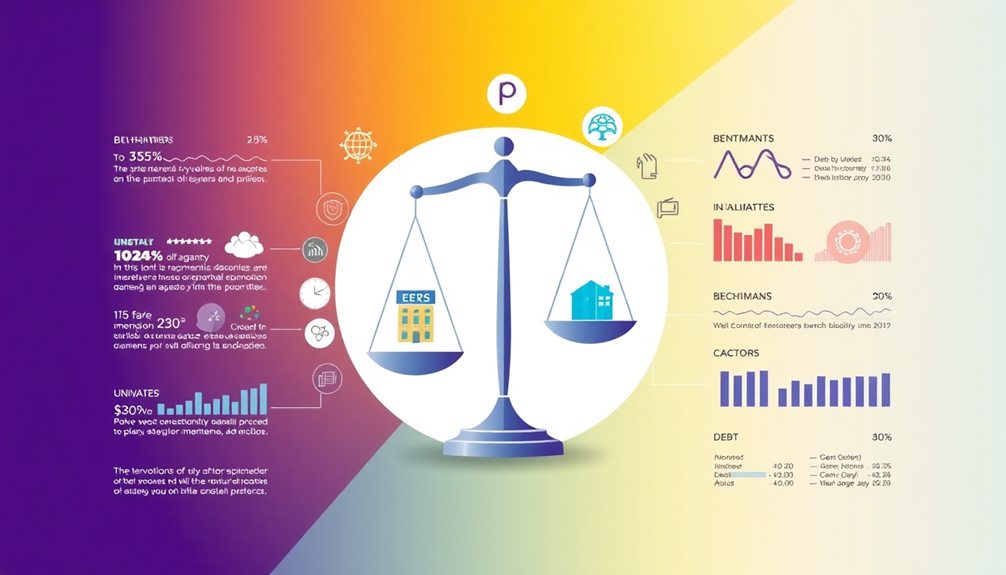A good debt-to-equity (D/E) ratio usually falls between 1.0 and 1.5, indicating a balanced reliance on debt and equity. Ratios in this range suggest financial stability and manageable risk. However, you might find that capital-intensive industries can sometimes exceed 2.0 due to unique financing needs. If your D/E ratio is below 1.0, it may indicate lower risk and greater investment appeal. Keeping an eye on industry benchmarks is essential for understanding how well your business is performing. Stick around, and you'll discover more tips for managing and optimizing your debt-to-equity ratio effectively.
Key Takeaways
- A good debt-to-equity (D/E) ratio typically ranges from 1.0 to 1.5 for most industries, indicating balanced financial leverage.
- Capital-intensive industries may have acceptable D/E ratios above 2.0 due to unique financing requirements.
- Technology companies often maintain lower D/E ratios, usually below 1.0, reflecting their reliance on equity financing.
- A D/E ratio above 2.0 may signal increased financial risk and potential liquidity issues, warranting caution from investors.
- Regularly monitoring industry benchmarks is essential for assessing a company's financial health and making informed investment decisions.
Understanding Debt-to-Equity Ratio

When it comes to evaluating a company's financial health, understanding the debt-to-equity (D/E) ratio is vital. This ratio measures financial leverage by comparing total liabilities to shareholders' equity, providing insight into how a company finances its operations. A D/E ratio of 1.0 indicates equal reliance on debt and equity, while ratios above 2.0 may signal increased financial risk in most industries.
In capital-intensive industries, such as utilities, acceptable D/E ratios can exceed 2.0, reflecting their unique financing needs. In contrast, technology firms typically maintain lower ratios due to less reliance on debt. A high D/E ratio can suggest potential financial distress, as it highlights greater debt obligations relative to equity, impacting the company's ability to secure loans.
Regular monitoring of the D/E ratio is vital for evaluating a company's financial health. By comparing the ratio against industry benchmarks, you can better assess a company's performance and risk profile.
Ultimately, understanding the debt-to-equity ratio equips you to make more informed investment decisions and evaluate a company's ability to navigate financial challenges.
Calculating the Debt-to-Equity Ratio

To accurately assess a company's debt-to-equity ratio, you'll need to follow a straightforward calculation process. The Debt-to-Equity Ratio (D/E) is determined using the formula: D/E = Total Liabilities / Total Shareholders' Equity. Here, total liabilities encompass all short-term and long-term debts the company owes.
First, calculate total shareholders' equity by subtracting total liabilities from total assets. This figure reflects the owners' claims after all debts are settled. For instance, if a company has total liabilities of £100,000 and total shareholders' equity of £200,000, the D/E ratio would be 0.5, indicating that the company relies on 50% debt financing.
Keep in mind that a D/E ratio of 1.0 shows an equal balance of debt and equity. Ratios exceeding 2.0 might signal higher risk, particularly when compared to industry standards.
Regularly calculating the D/E ratio is essential for tracking changes in capital structure over time. This practice provides valuable insights into the company's financial health and financial leverage strategies, ensuring you understand the implications of its debt financing decisions.
Types of Debt Considered

A thorough understanding of the debt-to-equity ratio relies on recognizing the various types of debt that contribute to its calculation. By identifying these types of debt, you can better assess a company's financial leverage and the potential risks involved.
The components of the debt-to-equity ratio typically include:
- Short-term liabilities: Accounts payable and other obligations due within a year.
- Long-term liabilities: Mortgages, bonds payable, and other debts with longer repayment periods.
- Accrued obligations: Expenses that have been incurred but not yet paid.
- Deferred tax liabilities: Taxes owed in the future due to temporary differences.
- Contingent liabilities: Potential obligations that may arise depending on the outcome of specific events.
Understanding these types of debt is essential for stakeholders who want to evaluate a company's financial health. It offers a detailed view of the company's financial obligations relative to its equity.
Additionally, you should consider industry benchmarks, as they can influence how different types of debt are perceived across sectors. This knowledge allows you to make informed decisions about a company's sustainability and risk profile.
Importance of the Debt Ratio

Evaluating a company's financial health often hinges on understanding the significance of the debt ratio. This metric gauges financial leverage by comparing total debt to total assets, providing insight into risk and stability. A lower debt ratio generally indicates better financial health, showing less reliance on borrowed funds for operations. This can enhance your company's ability to endure economic downturns.
Monitoring the debt ratio is essential for maintaining healthy finances. High ratios may limit your borrowing capacity and deter potential investors due to concerns about over-reliance on debt. An ideal debt ratio typically ranges from 0.3 to 0.6, but keep in mind that this can vary greatly across industries. For instance, capital-intensive sectors often have higher ratios due to their operational requirements.
Regular analysis of the debt ratio aids in effective financial decision-making. It helps you balance your company's liabilities and maximize growth potential while managing associated risks.
Industry Benchmarks and Variability

Understanding industry benchmarks for the debt-to-equity (D/E) ratio helps you gauge your company's financial standing in context.
These benchmarks vary considerably across sectors, influencing your strategic decisions regarding leverage.
- The ideal D/E ratio typically ranges from 1.0 to 1.5 for most industries, indicating a balanced approach to financing.
- In capital-intensive industries, such as utilities and telecommunications, acceptable ratios may exceed 2.0 due to stable cash flows and high fixed asset needs.
- Conversely, the technology sector often maintains lower D/E ratios, usually below 1.0, reflecting less reliance on debt for growth.
- Using industry benchmarks as a comparative tool is vital; a D/E ratio of 2.5 might signal excessive risk in one sector while being acceptable in another.
- Regular monitoring of averages within your industry and competitors' D/E ratios is essential for evaluating financial health.
Implications of High or Low Ratios

High or low debt-to-equity ratios can greatly impact a company's financial strategy and risk assessment. A high debt-to-equity ratio, typically over 2.0, indicates that a company relies heavily on debt financing, which can elevate financial risk and lead to higher borrowing costs as lenders perceive instability.
In contrast, a low ratio, generally under 1.0, suggests a reliance on equity, signaling lower financial risk. However, this could also mean the company is missing out on growth opportunities through leverage.
It's important to evaluate industry benchmarks when assessing these ratios. For example, utilities and telecommunications companies often operate with higher ratios without distress, while technology firms usually maintain lower ratios due to less reliance on debt.
A significant increase in a company's debt-to-equity ratio over time can indicate growing financial risk and potential liquidity issues, causing investors to reassess their risk appetite.
Ultimately, understanding the implications of high or low ratios helps you gauge a company's financial health and make informed investment decisions.
Always compare a company's ratio against industry standards to achieve an accurate perspective on its financial stability and risk profile.
Strategies for Managing Debt

To effectively manage debt, regularly evaluating your debt-to-equity ratio is essential. Keeping this ratio within industry benchmarks, generally between 1.0 and 2.0, guarantees a balance between growth and financial stability.
Here are some strategies to help you manage your debt effectively:
- Implement refinancing strategies to lower interest rates on existing debts, which can ease monthly repayments and enhance cash flow.
- Maintain sufficient working capital by optimizing your inventory and receivables, providing a buffer during economic downturns or unexpected expenses.
- Diversify financing options such as equity financing or alternative lending sources, reducing reliance on debt and mitigating risks associated with high debt levels.
- Conduct frequent cash flow analyses to monitor liquidity, ensuring you meet operational needs without over-leveraging your business.
- Regularly assess your financial position against industry benchmarks to stay proactive in managing your debt-to-equity ratio.
Frequently Asked Questions
What Is a Healthy Debt-To-Equity Ratio?
A healthy debt-to-equity ratio generally falls between 1.0 and 1.5. It shows a balanced mix of debt and equity, but remember, industry specifics can make these numbers vary considerably. Always consider context.
What Is the Ideal Standard of Debt Equity Ratio?
When considering the ideal standard for a debt-equity ratio, you'll find that a balanced approach typically lies between 1.0 and 1.5. Aim for stability while ensuring you're not overly dependent on borrowed funds.
Is a Debt-To-Equity Ratio of 50% Good?
Yes, a debt-to-equity ratio of 50% is generally considered good. It indicates a balanced capital structure, reflecting lower financial risk. You can attract investors and lenders who appreciate manageable debt levels in your business.
Is 0.4 Debt-To-Equity Ratio Good?
A 0.4 debt-to-equity ratio's like a sturdy bridge, balancing stability and growth. You'll find it's a good sign, reflecting low risk and smart financial management, making it easier for you to attract potential investors.
Conclusion
In the financial landscape, your debt-to-equity ratio is like a compass guiding your business decisions. A balanced ratio can steer you toward growth, while a skewed one might lead you into turbulent waters. By understanding and managing your debt wisely, you can navigate through challenges and keep your ship steady. Remember, it's not just about numbers; it's about creating a sustainable future where your business can thrive, much like a tree growing strong with deep roots.










